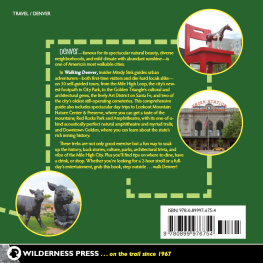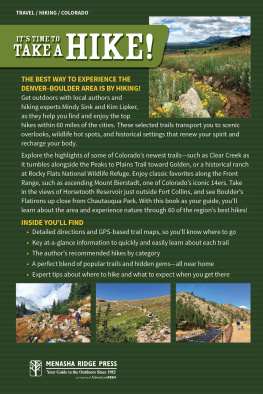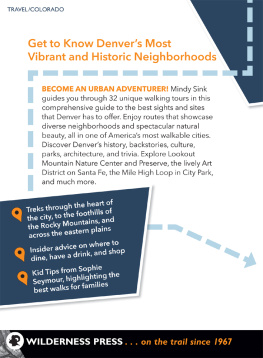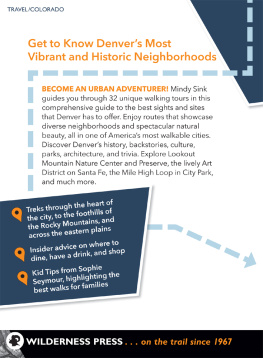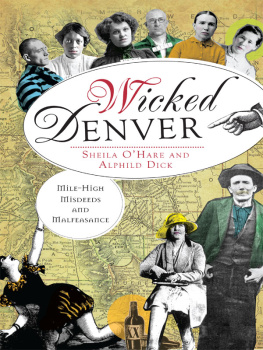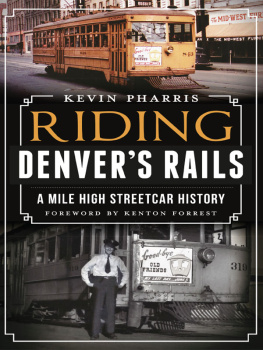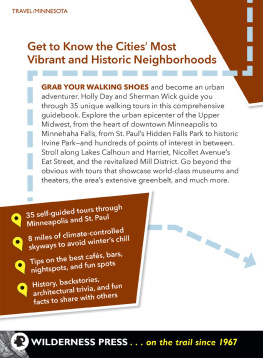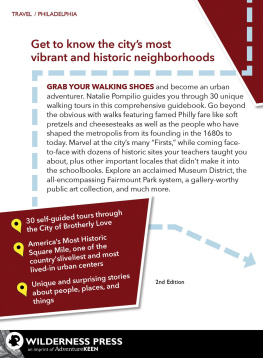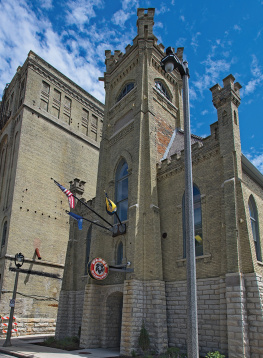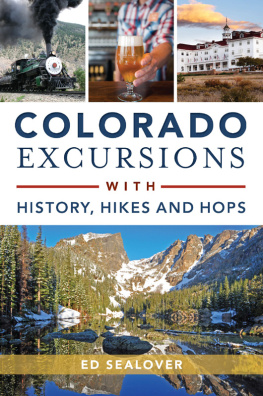

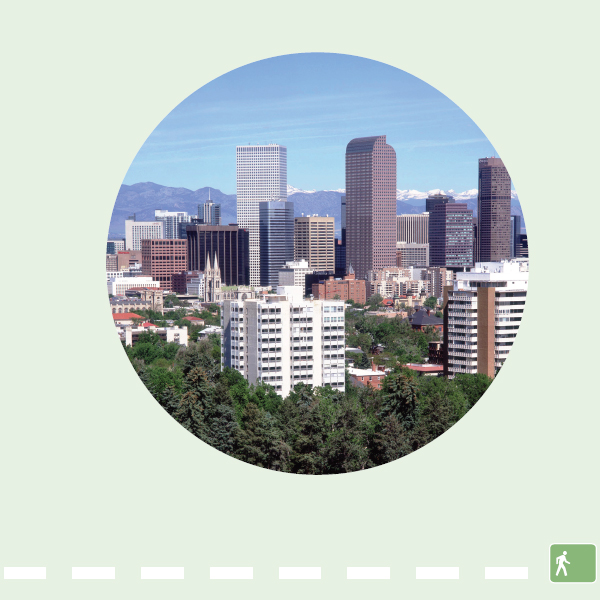

Walking Denver: 30 tours of the Mile High Citys best urban trails, historic architecture, river and creekside paths, and cultural highlights
1st EDITION 2011
Copyright 2011 by Mindy Sink
Cover photos copyright 2011 by Mindy Sink
Interior photos by Mindy Sink unless otherwise noted
Maps: Scott McGrew
Cover and book design: Larry B. Van Dyke and Lisa Pletka
Book editor: Holly Cross
ISBN 978-0-89997-675-4
Manufactured in the United States of America
| Published by: | Wilderness Press |
| Keen Communications |
| PO Box 43673 |
| Birmingham, AL 35243 |
| (800) 443-7227; FAX (205) 326-1012 |
| info@wildernesspress.com |
| www.wildernesspress.com |
Visit our website for a complete listing of our books and for ordering information.
Distributed by Publishers Group West
Cover photos: Front, clockwise from bottom center: Denver Art Museum, Civic Center Park and Golden Triangle; Confluence Park, Platte River Valley; Red Rocks Amphitheatre, Red Rocks Park and Amphitheatre; Coors Field, LoDo; On the War Trail by Alexander P. Proctor, Civic Center Park and Golden Triangle; Colorado State Capitol Building, Capitol Hill; I See What You Mean (The Big Blue Bear) by Lawrence Argent, 16th Street Mall/Downtown. Back, clockwise from bottom left: Scottish Angus Cow and Calf by Dan Ostermiller, Civic Center Park and Golden Triangle; The Yearling by Donald Lipski, Civic Center Park and Golden Triangle; Union Station, LoDo.
Frontispiece : Denvers skyline set against the Rockies. Photo courtesy of Visit Denver.
All rights reserved. No part of this book may be reproduced in any form, or by any means electronic, mechanical, recording, or otherwise, without written permission from the publisher, except for brief quotations used in reviews.
SAFETY NOTICE : Although Wilderness Press and the author have made every attempt to ensure that the information in this book is accurate at press time, they are not responsible for any loss, damage, injury, or inconvenience that may occur to anyone while using this book. You are responsible for your own safety and health while following the walking trips described here. Always check local conditions, know your own limitations, and consult a map.
ACKNOWLEDGMENTS
While I pride myself on being a pedestrian in Denver whenever possible, I did seek out expertise when deciding on which walks to include in this book. I must thank Rich Grant of Visit Denver for his always frank and sage advice on the Mile High City. Also, thanks to Heather Quiroga of Historic Denver for the generous access to their library and personal insight on Littleton. My appreciation also for my husband, Mike Seymour, and our daughter, Sophie, for listening to me recount the highlights of each walk over dinner and for their loving support.
My gratitude also to editor Roslyn Bullas who accepted my proposal and got me started on this project. And thanks to editor Holly Cross whose kind enthusiasm for these walks was so helpful as I practically ran through them!
AUTHORS NOTE
With the mild climate and nearly year-round sunshine in Denver, you can enjoy a walk in any season here. And, yes, some of the walks reach that exact 5,280 feet mark above sea level here in the Mile High City (and higher when you get into the foothills). Keep that elevation in mind when out for a walkespecially if you are not a localand always have water, sunscreen, and a hat. Even on a seemingly flat city walk, the altitude can be a factor, so be sure to rest often and stay hydrated. Its a good idea to wear layers when out for a walk too, as the day can start off chilly, then become hot quickly with the bright sun. Conversely, it can cool off fast when the sun goes down.
I would never brag about my sense of direction, but at least I know that the mountains are always to the west and can orient myself. Let them prevent you too from getting turned around while walking Denverand enjoy the view!

Numbers on this locator map correspond to Walk numbers.
INTRODUCTION
Denver is a compact city that is great for walking around, and it is also surrounded by some wonderful places worthy of walks that can feel like a little vacation.
This book was written with the idea that many of these walks can be combinedto possibly explore adjacent neighborhoods or to simply make for a longer walk on a beautiful day. The really ambitious pedestrian could connect the first 11 walks, or take one walk and then after a short light-rail train ride, take another walk too.
Although Denver has the 10th largest downtown in the country, that area is so compact that within a one-mile radius you can walk to a majority of the Mile High Citys historic, architectural, and cultural highlights.
Beyond the appeal of the city itself are some intriguing towns and places to walk abouteach with a strong connection to Denver, such as a prolific architect, a city that was once the state capital, or a terrific view of Denver itself.
Its not just that there is a lot to see and do in Denver for locals and tourists alike, but that those sites or towns are best enjoyed on foot when you can soak up the Colorado sunshine almost every day of the year, smell the pine trees, see the whimsical or historical public art, and stop in for a bite to eat along the way.
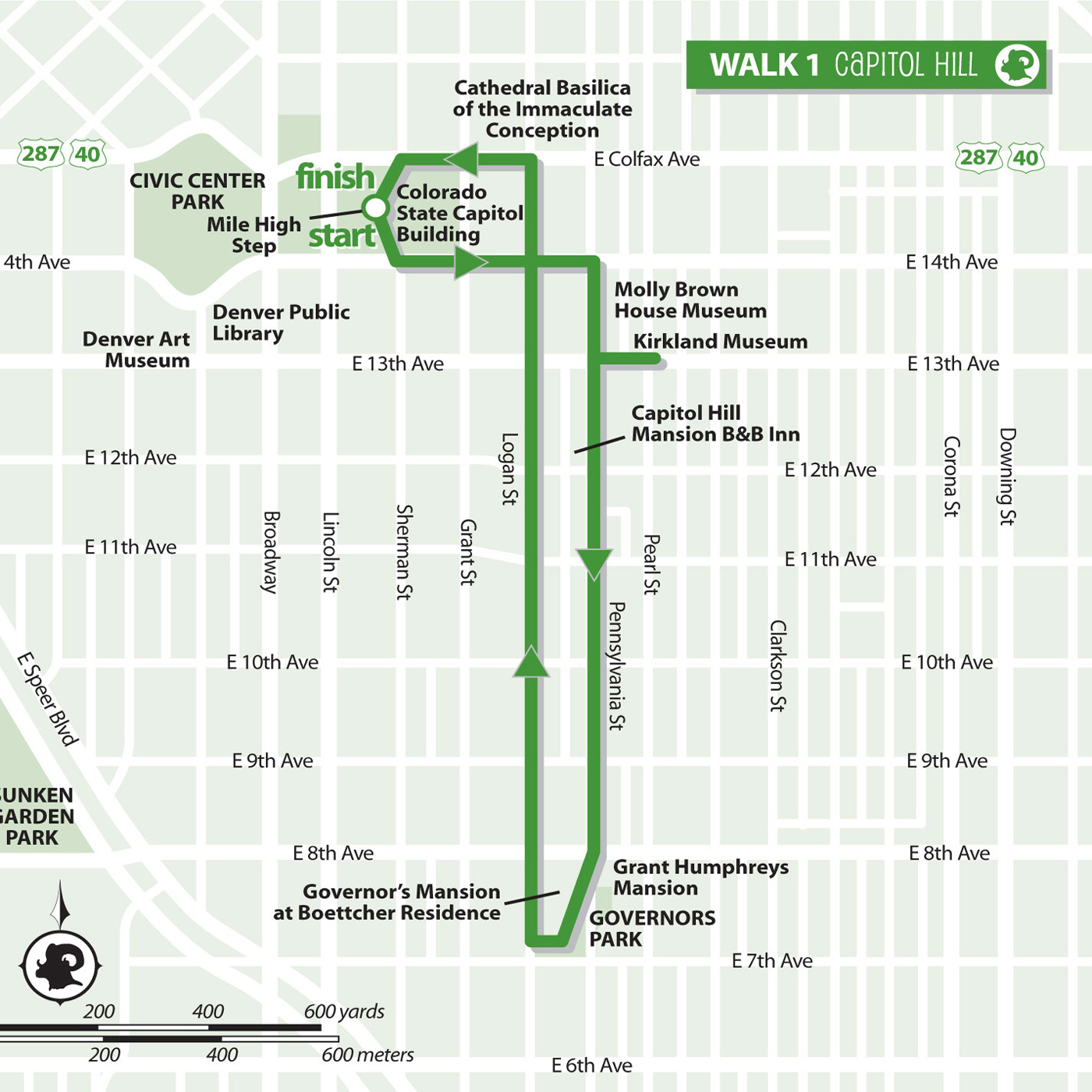
CAPITOL HILL: POLITICS AND ARCHITECTURE ROLLED INTO ONE
BOUNDARIES: Colorado State Capitol Building, 14th Ave., Pennsylvania St. Governors Park, Logan St., Colfax Ave.
DISTANCE: 2 miles
DIFFICULTY: Easy
PARKING: Metered on-street parking is available along Sherman St., which intersects State Capitol Building, and on Grant St. on the east side.
PUBLIC TRANSIT: Across the street from RTD free mall shuttle bus and bus station; Denver B-cycle (denverbcycle.com) has nearby bicycle rental stations at 13th Ave. and Pennsylvania St., 12th Ave. and Sherman St., and elsewhere.
Denvers Capitol Hill neighborhood offers a peek into the citys earliest years and how the boom and bust cycles affected even just a few blocks, as castle-like mansions went up and then fell into disrepair when apartment buildings were built next door. Once homesteaded land beyond the muddy streets of downtown, this little slope was soon recognized for its views of the mountains and remove from the noise and chaos of city life. In 1868, Henry C. Brown (owner of the Brown Palace Hotel) donated his acreage for the capitol buildingonly to take it back and put grazing livestock on it when the construction did not begin as soon as he had wanted it to. A lawsuit secured the land rights, and the grand structure was completed in 1908. Meanwhile, many of the citys wealthiest citizens had mansions built in the vicinity, only to have to sell them after the Silver Crash of 1893. J. J. Brown, husband of the Unsinkable Molly Brown (no relation to Henry C. Brown), moved into the neighborhood in 1894. (He made his fortune in gold and copper.) The couple made their mark on Capitol Hill and Denver with their wealth and charity, and on this walk youll see their former home as well as other institutions they funded. Today the Capitol Hill neighborhood is a hybrid of architectural elements with Art Deco apartments, beautifully restored historic homes and churches made from stone and brick, high-rise buildings, and other curiosities.

